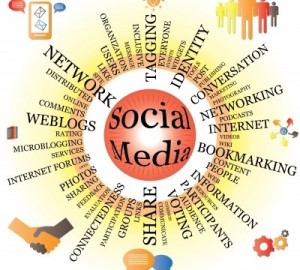When learning a new skill or just having a genuine interest in something work or pleasure related, having a personal learning network can be helpful. It allows you access to global learning communities and expertise, a place to discuss with others and ask questions, and many sources of information and knowledge.

Photo credit: StockMonkeys.com
YouTube
In starting to build my crochet personal learning network I subscribed to a few YouTube Channels of the crocheters I watched most often. From here, I found there Facebook pages and blogs which I joined and followed. My favourite YouTubers so far are Crochet Guru, Expression Fiber Arts, and Made With Love By Glama. Glama even responded to a question I asked after one of her videos.
Twitter
To find crocheters on Twitter to follow, I initially used Feedly. This, however, was probably not the best way. Most of the crocheters I followed from here were just posting pictures of items they were selling on Etsy. I had to unfollow some of them because my entire feed was filled with the same pictures over and over again. After this fail, I used the Twitter hashtag #crochet to find other crocheters. This has worked out much better.
Facebook
I have joined a couple of Facebook crochet groups. I like these because people share things they have crocheted so you can pick up ideas. My favourite thing is that you can ask questions and many people could answer you. None of my questions got answered, but I will keep trying!

Photo credit: Pixabay.com
Blogs
Blogs/blogging is a great way to expand your PLN. Clearly, I am blogging about learning to crochet and I have asked questions and posted resources to connect with other crocheters. I also subscribe to other blogs. I can ask questions, see tutorials, get free patterns, etc. by reading other people’s blogs.
Feedly
Feedly is a great place to get all my crochet content in one place. Here I can add my favourite blogs and sites to see what’s new in the world of crochet.
Apps
I only have a couple crochet apps (check out this post to see which ones). Of those, the AllFreeCrochet.com app links you to a ton of different crochet articles. These are usually from people’s blogs, so it is another way to connect with fellow crocheters. Crochet For Beginners also allows you to connect through Facebook and to other people’s blogs.

Photo credit: mashable.com
Pinterest
I love Pinterest and it has been my go to place to find crochet. I already have 63 pins on my crocheting board! You can also follow other people with your similar interests to see what they are pinning.
Face-to-Face
Just because you’re learning a skill online, doesn’t mean you can’t meet up with someone and have a face-to-face conversation. I happened to mention to my neighbour that I was learning to crochet and he told me his mom is a really good crocheter. Now when I get stuck on something, I can meet up with her for help.


 bigotry against women is widely considered to be “in bounds” by Internet commenters.”
bigotry against women is widely considered to be “in bounds” by Internet commenters.”









 This app is poorly organized and jumps all over the map. There is a menu section that includes titles such as Learning Basic Crochet Patterns (I didn’t find this section very helpful at all. I knew most of these stitches, but if I was just learning them it would be very inadequate) to How to Crochet a Cat Hat (not very high on my priority list). There were three sections to do with the Treble Stitch and none of them explained how to treble stitch into the foundation chain. There is also a video section, which is pretty sparse. To me, it isn’t in a logical order and goes from how to single and double crochet to making a beanie. That seems like a big jump to me in terms of the skill level. The videos are also all available on YouTube for free. The videos that were selected aren’t necessarily the best ones available either. For example, the angle and distance from the camera in the video on single and double crochet stitches would make it very difficult to learn from.
This app is poorly organized and jumps all over the map. There is a menu section that includes titles such as Learning Basic Crochet Patterns (I didn’t find this section very helpful at all. I knew most of these stitches, but if I was just learning them it would be very inadequate) to How to Crochet a Cat Hat (not very high on my priority list). There were three sections to do with the Treble Stitch and none of them explained how to treble stitch into the foundation chain. There is also a video section, which is pretty sparse. To me, it isn’t in a logical order and goes from how to single and double crochet to making a beanie. That seems like a big jump to me in terms of the skill level. The videos are also all available on YouTube for free. The videos that were selected aren’t necessarily the best ones available either. For example, the angle and distance from the camera in the video on single and double crochet stitches would make it very difficult to learn from. This app brings you to a very large list of articles, most of which offer free patterns, link to crocheter’s blogs (these usually have many free patterns as well), or share information on different types of yarn.
This app brings you to a very large list of articles, most of which offer free patterns, link to crocheter’s blogs (these usually have many free patterns as well), or share information on different types of yarn. This is actually an app to get the monthly magazine subscription on your device, but it does give 10 free magazines. I skimmed the first two issues and they weren’t half bad. They have articles on different types of stitches, crocheting different pieces such as a scarf, essential crochet tips, linguistics of crochet, crochet supplies, etc. It even includes links to videos the author thinks are very helpful.
This is actually an app to get the monthly magazine subscription on your device, but it does give 10 free magazines. I skimmed the first two issues and they weren’t half bad. They have articles on different types of stitches, crocheting different pieces such as a scarf, essential crochet tips, linguistics of crochet, crochet supplies, etc. It even includes links to videos the author thinks are very helpful. This app has 5 sections:
This app has 5 sections: Photo Credit:
Photo Credit:  Photo Credit:
Photo Credit:  Photo Credit:
Photo Credit:  Photo Credit:
Photo Credit:  Photo Credit:
Photo Credit: 


 ally know what I was looking for, and got started on another dishcloth. This one I’ll actually be able to use! The stitch markers were quite helpful because I found that it was more difficult to distinguish which was my first stitch with the cotton yarn. That made counting stitches challenging and I was never sure if the number I came up with was correct. Even with using the stitch markers, I managed to screw up at one part. Hopefully when I figure out how to edge properly it will hide this mistake somewhat.
ally know what I was looking for, and got started on another dishcloth. This one I’ll actually be able to use! The stitch markers were quite helpful because I found that it was more difficult to distinguish which was my first stitch with the cotton yarn. That made counting stitches challenging and I was never sure if the number I came up with was correct. Even with using the stitch markers, I managed to screw up at one part. Hopefully when I figure out how to edge properly it will hide this mistake somewhat.

 Photo credit: phdstudents.tumblr.com
Photo credit: phdstudents.tumblr.com
